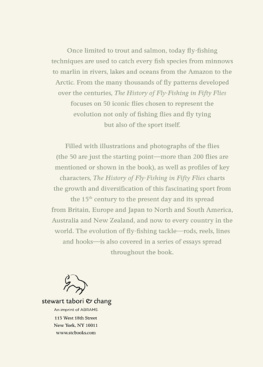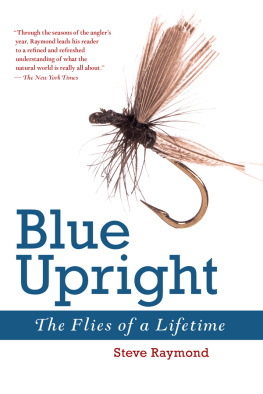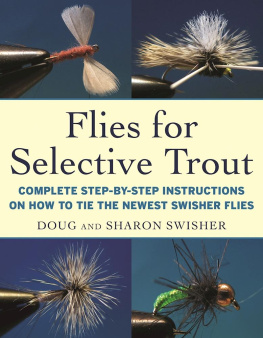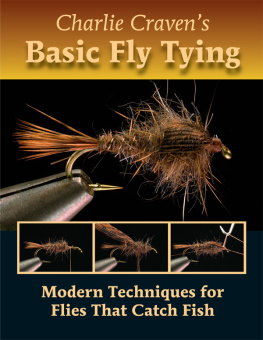For Sharon. You make fly tying fun.
Copyright 2013 by Skyhorse Publishing.
All Rights Reserved. No part of this book may be reproduced in any manner without the express written consent of the publisher, except in the case of brief excerpts in critical reviews or articles. All inquiries should be addressed to Skyhorse Publishing, 307 West 36th Street, 11th Floor, New York, NY 10018.
Skyhorse Publishing books may be purchased in bulk at special discounts for sales promotion, corporate gifts, fund-raising, or educational purposes. Special editions can also be created to specifications. For details, contact the Special Sales Department, Skyhorse Publishing, 307 West 36th Street, 11th Floor, New York, NY 10018 or info@skyhorsepublishing.com.
Skyhorse and Skyhorse Publishing are registered trademarks of Skyhorse Publishing,
Inc., a Delaware corporation.
Library of Congress Cataloging-in-Publication Data is available on file.
Introduction
Deciphering the Challenge of the Rising Trout
SUCCESSFULLY CASTING A DRY FLY TO A FEEDING TROUT IS the pinnacle of the fly anglers art. The first steps are identifying what the fish is eating, selecting the correct forgery, and choosing the proper position in the river from which to cast. Even the angle of the light and potential shadows that might alarm your quarry must be considered.
You fall into rhythm with the rising trout and the flowing water. You cast the fly just ahead of the fish, and just a moment before it should return to the surface to snatch another winged morsel. You tend the line both before and after it drops to the water. The bits of feather and fur, tied to a piece of bent wire, bob with the speed of the current. You wait and watch.
If youve considered the problem correctly and handled your tackle properly, a slick wet nose will poke through the surface to suck in your fly. You may now consider yourself a good angler. A very accomplished fly fisher can do this repeatedly, intuitively going through the steps that lead to tugs on the end of his line.
Its said that nymphs catch more trout and streamers fool bigger fish, but nothing beats the joy of seeing that wet nose intercept your fly from the top of the water.
This book is about dry flies. Not all dry flies, but favorite dry flies101 flies, to be exact. I have selected some of my favorite patterns, and a group of angling friends chose some of theirs. What follows is a collection of floating flies that will catch trout anywhere.
Each entry contains a clearand hopefully artfulphotograph of the fly, a precise materials recipe, and a small story describing the pattern. Sometimes I tell the history of the fly or offer a few tying or fishing tips. Other times I discuss what the pattern imitates and give a brief lesson in streamside entomology. The material is as varied as the flies themselves.
Theres no way a small book can contain every favorite fly; in fact, I am including a few patterns that have never appeared in print. But, each fly has been chosen and tied by an experienced angler, the kind of fisherman who can intuitively decipher the challenge of the rising trout.
David Klausmeyer
Spring 2013

Acknowledgments
101 FAVORITE DRY FLIES: HISTORY, TYING TIPS, AND FISHING STRATEGIES contains a fistful of patterns you can use to catch trout wherever they swim. I have included a few of my own flies, but have also relied on the help of many friends in compiling this small collection. They are all expert anglers and fly designers, and when they recommend a pattern, we should all listen.
But I am writing in the present tense, which is not entirely accurate: two of the contributorsFran Betters and Warren Duncanare no longer with us. Their influence on fly fishing and tying, however, will remain timeless.
My heartfelt thanks to the following gentlemen (and ladies) for helping with this project:
Tom Baltz
Al and Gretchen Beatty
Fran Betters
Gary Borger
Bill Black
David Brandt
Dennis Charney
Warren Duncan
Jay Fishy Fullum
Keith Fulsher
Aaron Jasper
Claes Johansson
Craig Mathews
Dennis Potter
Jesse Riding
Al Ritt
Mike Romanowski
Ted Rogowski
Ed Shenk
Mike Valla
Ken Walrath
Sharon E. Wright
CHAPTER ONE

Matching
the Hatch:
Mayflies,
Caddisflies,
and Stoneflies
1
Slow-water,
Blue-winged Olive

Hook: Standard dry-fly hook, sizes 20 to 16.
Thread: Olive 8/0.
Tail: Dark pardo Coq de Leon.
Body: Stripped peacock quill, dyed olive.
Thorax: Olive Superfine dubbing.
Wing post: White Hi-Vis polypropylene yarn.
Hackle: Grizzly.
THE SLOW-WATER, BLUE-WINGED OLIVE IS EXTREMELY productive in slow-water scenarios where the trout are ultra selective. The body is very slender, and when combined with a light-wire hook, this pattern is extremely buoyant.
The parachute-style hackle on the Slow-water, Blue-winged Olive makes the fly float on the surface with the body resting in the film like a real emerger. This pattern creates a realistic-looking silhouette on the water, which is necessary when fishing for very discerning trout in slower moving sections of a stream.
Feel free to swap other colors of yarn for the wing post. Hot pink and orange are easy to track on the watereven in failing light, and the fish do not seem to notice these bright colors.

2
Hovering Green Drake Emerger

Hook: Partridge Klinkhamer hook, size 10.
Thread: Brown 6/0.
Tail: Dingy olive marabou tips.
Abdomen: Dingy olive marabou.
Rib: Extra-fine copper wire or clear monofilament.
Thorax: Peacock herl.
Wing bud: Cul de canard.
Hackle: Grizzly, dyed tan, or Cree.
Indicator: Closed-cell foam.
AS AN AUTHOR, ITS FUN TO SHARE SOME OF YOUR OWN patterns, and this is one of minewell, sort of. I made several changes to the classic Quigley Cripple, so many, in fact, that most fly designers would claim it as an entirely new pattern. When I look at the Hovering Green Drake Emerger, however, I still see the basic form of Bob Quigleys famous fly, so I think of it as more of a second or third cousin. Its different, but there is no denying the family resemblance.

















